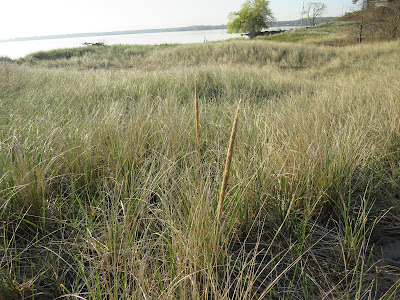It’s early morning as I make my way through a remote, woodland while being serenaded by the familiar song of a Robin. With partly sunny skies and temperatures in the mid 60’s, I’m once again in the Edmore State Game Area proceeding west toward another encounter with the North Branch of the Pine River. Passing through muddy lowlands with pooling water, I spot a few Cinnamon ferns displaying their spore stalks as well as patches of Sensitive ferns and Skunk Cabbage, some with huge, 18-inch leaves. Beside the trail, I see my first Daisy Fleabane blossoms of the year as well as blossoms of Wild Columbine. Getting closer to the river channel, I come upon an unfamiliar ¾-inch moth resting on a leaf. The best I can tell, it’s a Powdered Big Wing moth. The name “powdered” refers to tiny scales on their wings that look and act like dust. These scales, which are actually tiny hairs, help create the intricate patterns you see on its wings. These patterns appear in dull colors such as brown and black. Most moths fly at night, so they don't need the bright colors of butterflies. The dull colors help a moth camouflage itself as it perches during the day. Because a moth is active at night, scales provide an insulating layer to help the moth stay warm. Overhead, a flock of noisy geese fly in formation with 2 stragglers trying to catch up. Reaching the river’s edge, I take in the lush surroundings of late spring. Exploring the flood plain, yellow blossoms of Buttercup and Butterweed catch my eye. Butterweed is toxic to both cattle and horses. Even deer avoid it. The plant contains an alkaloid called pyrrolizidine which causes liver damage. Cattle and horses who dine on this plant don’t just drop dead but decline in health and eventually die. Back to the river’s edge, I pause to watch the water flow gently past. Turning back toward the car, I come upon my first Ebony Jewel wing damselfly of the season as well as a colorful, 1-inch Pearl Crescent Butterfly. As the rays of a rising sun begin to penetrate the forest, I spot blossoms from a nearby Hawthorn tree as well as a Jack-in-the-pulpit. Nearing the car, I see a pile of sawdust on a fallen log, evidence of Carpenter ants at work.
Running fast, running slow
Carries leaves, broken twigs
Around a bend, on you flow
Water striders, Whirligigs
Swollen channel, banks erode
Cattail seeds, floating logs
Water treasure, precious load
Mallard ducks, leopard frogs
Summer rapids, winter ice
Earth’s resource, life giver
Too important to sacrifice
North branch, Pine River
D. DeGraaf




